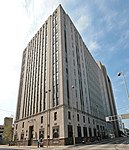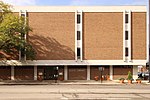Isaac M. Wise Temple

The Isaac M. Wise Temple (formerly the Plum Street Temple) is the historic synagogue erected for Rabbi Isaac Mayer Wise and his congregation in Cincinnati, Ohio. Wise was among the founders of American Reform Judaism. The temple building was designed by prominent Cincinnati architect James Keys Wilson. Its design was inspired by the Alhambra at Granada.The temple is located at 720 Plum Street in Cincinnati, Ohio and was built by members of the Lodge Street Synagogue. It was built chiefly during the Civil War, at a cost of $275,000. The temple was dedicated on Friday, August 24, 1866, and is among the oldest synagogue buildings still standing in the United States.The temple is across Plum Street from the historic Saint Peter In Chains Cathedral and next to the site of the former St. Paul Episcopal Cathedral, which was torn down in 1937. In 1972, the Plum Street Temple was placed on the National Register of Historic Places, and it was designated a National Historic Landmark in 1975 for its architecture and its role in the Reform movement.
Excerpt from the Wikipedia article Isaac M. Wise Temple (License: CC BY-SA 3.0, Authors, Images).Isaac M. Wise Temple
Plum Street, Cincinnati West End
Geographical coordinates (GPS) Address External links Nearby Places Show on map
Geographical coordinates (GPS)
| Latitude | Longitude |
|---|---|
| N 39.103672222222 ° | E -84.518069444444 ° |
Address
Isaac M. Wise Temple
Plum Street
45203 Cincinnati, West End
Ohio, United States
Open on Google Maps











